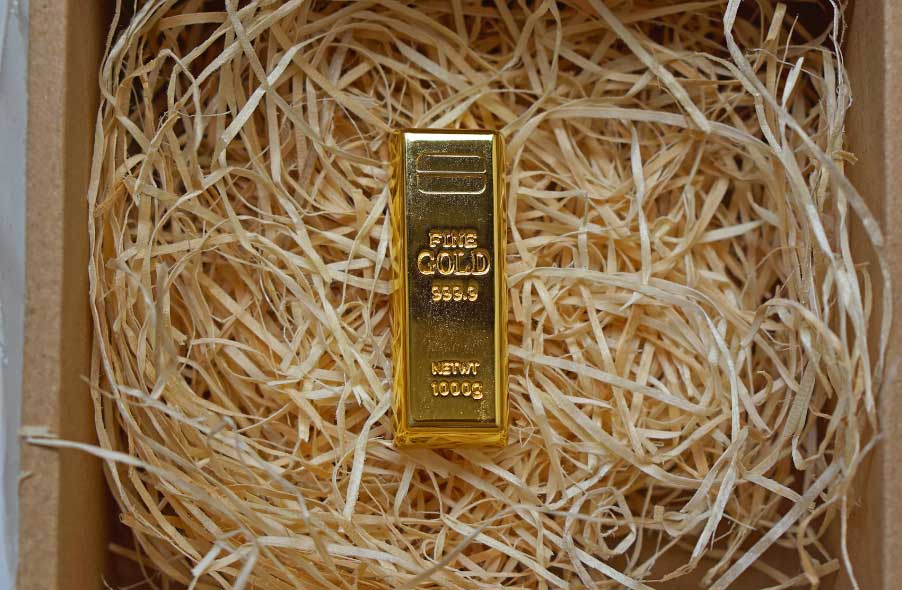Understand your retirement account with our gold IRA rollover guide.
Many people invest in an individual retirement account (IRA) to save money for retirement, with the extra benefit of tax advantages in the present. However, almost all IRAs focus on stocks, bonds, and mutual funds, which can lead to poor performance during economic downturns. Diversifying your retirement accounts by adding a self-directed gold IRA allows you to weather economic conditions better while gaining all the tax benefits of a traditional IRA.
One of the most challenging aspects of opening a new IRA for novice investors is moving funds between retirement accounts. If you decide to open a gold IRA, you’ll need to understand what a rollover is, how it works, and what the tax implications of moving funds will be. Our gold IRA rollover guide is here to help you navigate the process.
What Is a Gold IRA Rollover?
A gold IRA rollover is when you move funds from an existing 401(k) retirement account, or any other type of retirement account that is not an IRA, into your newly opened gold IRA. The process is simple but does come with several rules that you must follow to avoid IRS penalties.
The good news is that most reputable gold IRA companies have advisors to guide you through the process. You can also consult with your financial advisor on how to best proceed.
Why Do a Gold IRA Rollover?

The main reason to do a gold IRA rollover is to put funds into your new gold IRA. You’ll need to use these funds to purchase your gold or other precious metals.
The IRS has limits on how much you can deposit into an IRA annually ($6,500 for people younger than 50, $7,500 for people older than 50). Depositing more money into your IRA will incur tax penalties until you withdraw the excess funds.
A rollover doesn’t count as a contribution, which means that it isn’t subject to these annual limits. This lets you deposit significantly more money into your newly opened IRA and start investing in precious metals and diversifying your retirement accounts more effectively.
IRS Rules for a Gold IRA Rollover
The IRS has several rules in place to prevent people from abusing rollovers to avoid contribution limits. The main rule to note is that you have 60 days after withdrawing your funds from your existing 401(k) to fund your new IRA. Failing to do so will result in the IRS taxing your withdrawal as an early withdrawal from your retirement account, which means having to pay a tax penalty of 10% in addition to income tax on that withdrawal.
The other important rule to note is that you can only do one rollover from the same IRA within a one-year period. However, the IRS does not consider direct transfers of IRA money — the movement of funds from one IRA to another — as rollovers, meaning that direct transfers are not subject to the one-rollover-per-year rule.
How to Avoid Penalties When Doing a Gold IRA Rollover
Generally, there are no tax penalties associated with a gold IRA rollover as long as you transfer the funds directly from your 401(k) into your newly opened IRA as quickly as possible. If the funds don’t appear in your IRA within 60 days, the IRS will consider the withdrawal of these funds as a disbursement instead of a rollover and tax the withdrawal accordingly.
Make sure to speak with your financial advisor or tax consultant to avoid any unexpected penalties or surprises during a rollover. They will be able to guide you through the process and ensure a smooth and easy transfer of funds.
What Accounts Are Eligible for a Gold IRA Rollover?
The IRS allows an IRA rollover from any existing retirement account, including other IRAs or retirement accounts. You can also roll over any part of the distribution or the entirety of the existing IRA, except for the required minimum distribution.
Similarly, the IRS allows rollovers of all or any part of a retirement plan, with a few exceptions that you can find on its website.
The Difference Between a Transfer and Rollover

While some people may use the terms “transfer” and “rollover” interchangeably, the IRS does not. A “transfer” refers to the movement of funds from one IRA to another, usually by the custodian of your new gold IRA. A rollover refers to the movement of funds from another retirement account, such as your 401(k) into a gold IRA.
How to Move Funds from Your 401(k) to a Gold IRA
The first step in rolling over your funds is to open a gold IRA. You can do so through a trustee, gold IRA company, or registered self-directed IRA custodian who will help you establish your new IRA and register it with the IRS.
Once you have set up your gold IRA, you’ll need to consider various factors, including whether you want to do a direct or indirect transfer and which funds you want to move across. The simplest way to move funds is from one IRA to another, as this process doesn’t require any further input from you, while other types of rollovers can quickly become complicated and time-consuming.
Generally, the best gold IRA companies will have procedures in place to guide customers through the rollover process. Direct transfers are very simple and require little action on your part, though indirect rollovers may be more complex. In the event of an indirect rollover, where you receive the funds before transferring them into your gold IRA, reach out to your company at any time if you have questions.
Rolling over funds from a 401(k) sponsored by a former employer is simple, as their contribution ends when your employment does. The largest potential hurdle with a rollover is if you have a 401(k) sponsored by an existing employer, which may have restrictions or rules regarding rollovers into self-directed IRAs. The best thing to do in this case is to call your employer and read up on the rules of rollovers to gold IRAs.
Direct vs. Indirect Rollover
In most cases, your gold IRA company or custodian will initiate a transfer of funds from your existing retirement account to your newly opened IRA. Direct rollovers can happen in several ways, such as:
- Your IRA custodian initiating a transfer of funds with your approval
- Your existing 401(k) plan administrator rolling over the funds to the designated IRA
- Receiving a check made out in the name of the newly opened retirement account and forwarding it to the new institution
An indirect rollover is a bit more complex and involves taking over the rollover funds yourself. During an indirect rollover, your existing plan administrator will liquidate the assets in the fund and either send you a check or deposit the money in your personal bank account. You then need to take this money and deposit it into your new IRA within 60 days to avoid paying early withdrawal penalties and income tax on the fund withdrawal.
A major downside of an indirect deposit is that your existing retirement account administrator is required, by law, to withhold 20% of the amount in taxes if they make out the withdrawal check to you. You’ll need to make up this amount to ensure you pay the full total into your new IRA to avoid paying taxes on the amount withheld.
For example, let’s say that you want to roll over $20,000 into a new IRA. Your existing account administrator will withhold 20% of that, or $4,000, and pay out $16,000. If you only deposit $16,000 into your new IRA, you’ll face tax penalties on the $4,000 in holding.
The best way to avoid this is to have the administrator write a check payable to the receiving plan or IRA.
Direct rollovers are generally a better option for most people, as they are faster and less prone to mistakes. You also won’t have to find additional funding sources to make up for the amount withheld by the plan’s custodian.
The one reason why some people consider an indirect rollover is if they plan to use the funds they receive but still pay the same amount into an IRA within 60 days. You can view this 60-day window as a loan to yourself, but doing so can be risky, and if you don’t deposit the correct amount into your IRA, you’ll have to pay a 10% penalty on the funds withdrawn.
Gold IRA Portfolio Allocation

The question that many gold IRA companies get is what precious metals to buy once they have funds in their gold IRA. While slightly out of the scope of our gold IRA rollover guide, asset allocation is an important consideration for your rollover, as it can help you determine how much money you want to transfer into your newly opened account.
The best person to help you decide on asset allocation is your financial advisor. They understand your current situation as well as your future savings goals, which gives them the insight necessary to provide relevant and useful advice.
Investing a good portion of your retirement into physical assets can be beneficial. The reasoning is that since gold isn’t tied to the stock market or economic situation, it is better suited to weather harsh economic conditions.
Typically, gold prices will rise during economic downturns as investors look for stable performers not tied to any fiat currency. Similarly, gold prices will drop as markets strengthen and investors move back to bonds, shares, and mutual funds. This almost inverse correlation means that no matter what the markets are doing, at least a portion of your portfolio is increasing in value.
Another important facet of your allocation strategy is deciding how much of your gold IRA should consist of physical precious metals as opposed to precious metals-related investments. Self-directed IRAs are surprisingly flexible in what you can invest in, and in addition to precious metals bullion, the IRS allows gold IRAs to purchase:
- Precious metals-related exchange-traded funds (ETFs)
- Precious metals mining companies
- Precious metals commodity futures
- Precious metals mutual funds
Setting Up Your Gold IRA
Setting up a gold IRA can feel intimidating, but luckily, there are plenty of gold IRA companies that can assist you in setting up and maintaining your gold investment.
These companies can help you open a new IRA account, move funds from your existing retirement accounts, and handle the buying and storage of gold for you. It’s important to note that while these companies are incredibly useful, they are not financial advisors. Many companies will have helplines and customer service to discuss your options, but these opinions do not constitute financial advice, and for more tailored guidance, speak to your dedicated advisor instead.
Once you’ve created an IRA account, the next step is to fund the account. You can do this by depositing some cash from your personal banking account, though be careful not to go over the IRS’s annual contribution limit. The IRS considers all contributions to all of your IRAs as part of this limit, so if you’ve already put money into a traditional IRA, you may not be able to fund your IRA using a contribution.
The most common option for funding an IRA is rolling over or transferring funds from your current retirement accounts. These transfers are usually tax-free and don’t count toward your contribution limit. Your gold IRA company can help you through the process, which usually involves a direct transfer from your 401(k) to your new IRA, as outlined in this gold IRA rollover guide.
Once you have funds in your account, you can use them to purchase gold or other precious metals. If you’re using a gold IRA company to manage your IRA, they will handle the buying, transport, and storage of your chosen gold investment.
It’s worthwhile learning about the various regulations the IRS has on precious metal investments, which include restrictions on the purity of gold, silver, platinum, and palladium you can buy, and where you can store your gold. If you want to use your physical precious metals as part of an IRA, you must store them in an IRS-approved depository. You also can’t use existing precious metals as part of your investment — you need to buy all your precious metals with funds from your IRA.
When looking for the best gold IRA company, also keep an eye out for providers that have some form of buyback policy. This lets you sell the gold back to the company if you decide to opt out of gold investing or need to liquidate your investment rapidly for whatever reason.
Finding a Gold IRA Custodian

Your IRA custodian is responsible for all of the tax administration of your gold IRA, which includes keeping track of purchases and sales and reporting annually to the IRS. While you may be able to handle the other aspects of maintaining a gold IRA, it’s mandatory to have a self-directed IRA custodian manage your IRA.
With traditional IRAs, finding a custodian is easy. Many financial institutions offer custodial services for traditional IRAs, including:
- Banks
- Insurance companies
- Mutual fund companies
- Brokerage firms
- Online investment platforms
Unfortunately, as the regulations for self-directed IRAs are very different from those of traditional IRAs, not all financial institutions offer custodial services for gold IRAs. A good place to start looking is the IRS’s list of approved non-bank trustees and custodians, which lists over 50 institutions that offer their services. When comparing various options, keep the following factors in mind:
- Experience
- Fees
- Expertise
- BBB Rating
- Security
Gold IRA Custodian vs. Gold IRA Company
While both gold IRA custodians and gold IRA companies help you manage your gold IRA, they are not the same thing. Custodians are institutions or individuals that are approved by the IRS and can hold the assets in your IRA. They deal with the tax-related aspects of your IRA, such as record-keeping and reporting.
IRA companies are intermediaries between you and the custodian, and they can handle all the other intricate aspects of a gold IRA, such as trading, transporting, and storing your precious metals. They typically work with industry-leading custodians and IRS-approved depositories, meaning that your only point of contact is the company itself, and it handles all the setting up and maintenance of your IRA.
If you decide to opt for a gold IRA company, you won’t need to look for a custodian or depository yourself, as the company will have its own preferred custodians that you can choose from. This route can give you peace of mind knowing that you’re working with a reputable IRS-registered custodian to manage your assets.
Choosing Precious Metal Products

The IRS has stringent regulations on the type of physical bullion you can buy. These regulations include:
- The purity (fineness) of the bullion. Minimum fineness requirements are 99.5% pure for gold, 99.9% pure for silver, and 99.95% pure for palladium and platinum.
- Bullion must come from a manufacturer accredited by one of the major precious metals exchanges, including NYMEX, COMEX, or TOCOM, or from a government mint.
- All proof coins must remain within their original packaging.
- Non-proof coins must be in brilliant uncirculated condition.
Bars vs. Coins
When it comes to bullion, the only factor that influences value is weight. This means that a 10 oz bar will have the same value as a 10 oz coin, which can make choosing between the two options relatively difficult.
Bars tend to come in a larger array of sizes than coins, which makes them a more flexible investment option. If you don’t plan on selling your bullion, buying a 100 oz bar of gold is cheaper due to lower commission fees and easier to store than 100 1 oz coins.
However, smaller value pieces are easier to liquidate, and coins can also gain in numismatic value unrelated to the gold price.
Taxes Involved in a Gold IRA Rollover
If done correctly, you should not incur taxes on a gold IRA rollover. Direct transfers are tax-free, and as long as you deposit any withdrawn funds into your new IRA within 60 days, indirect transfers should also remain tax-free.
The only time you’ll pay taxes on a gold IRA rollover is if you do an indirect transfer and fail to fund the IRA with the full amount within 60 days. The IRS considers this an early withdrawal and will charge a 10% penalty on the withdrawal plus income tax.
Is Rolling Over to a Gold IRA a Good Decision?
Gold IRAs are a good way to diversify your retirement portfolio and hedge against future negative market and economic conditions. However, not everyone’s situation is the same, and it’s always best to talk to your financial advisor before rolling over existing funds into a new self-directed IRA. If you are interested in working with a professional and getting a gold IRA rollover guide, contact us at Learn About Gold to learn more





